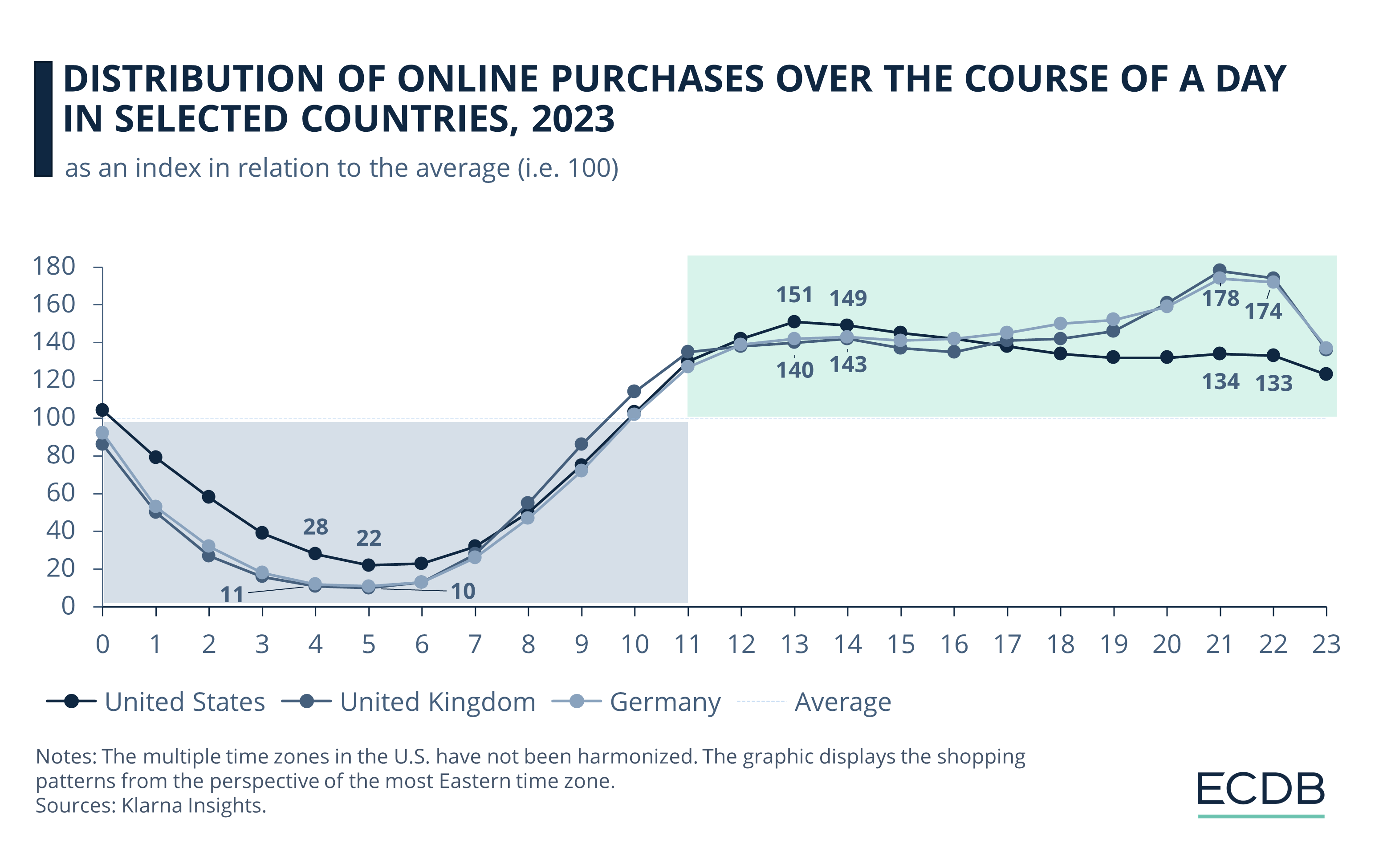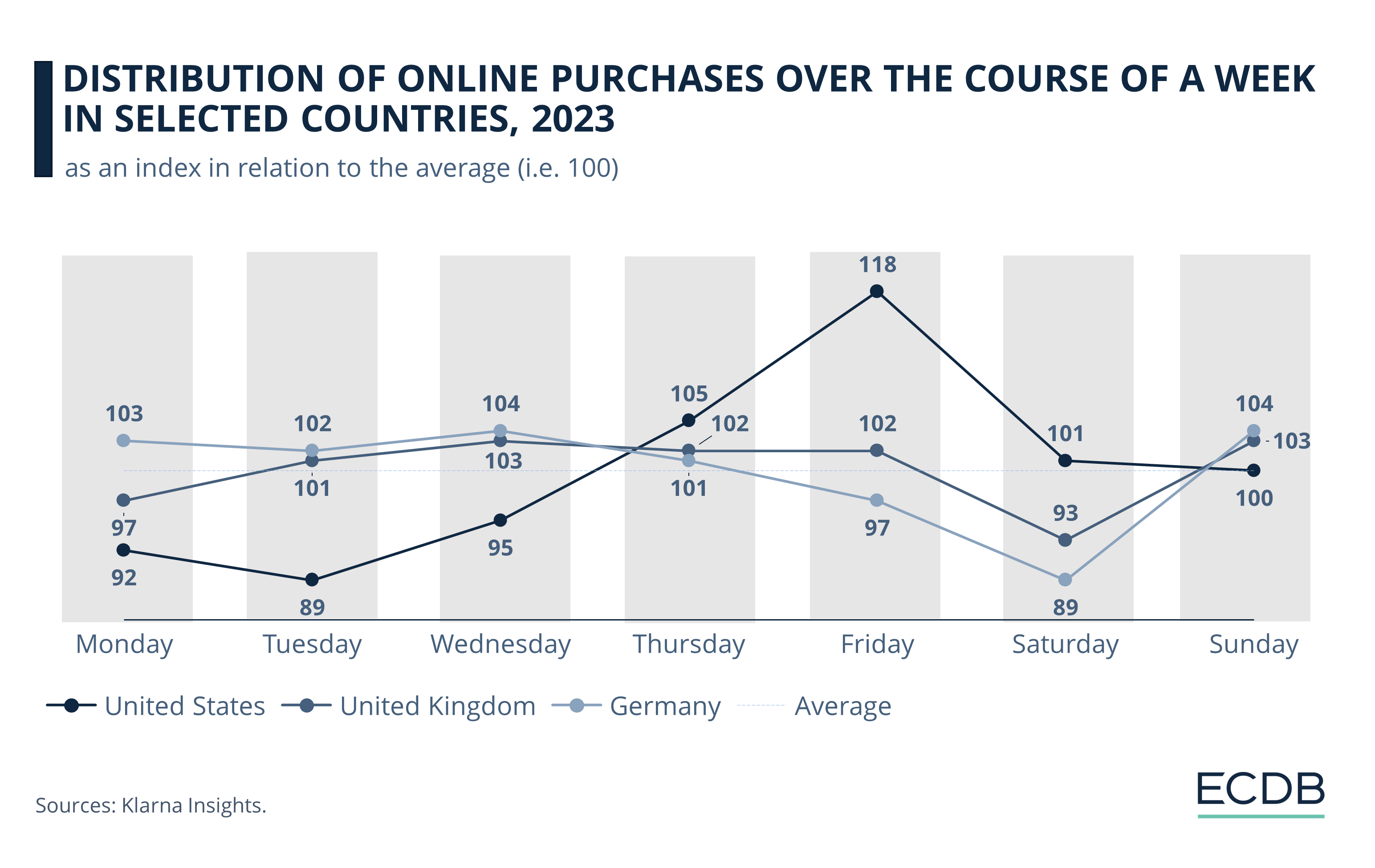eCommerce: Consumer Insights
Online Shopping Habits: The Golden Hours of eCommerce
Recent data from Klarna Insights shows the most popular hours and days for online shopping. Can you guess what time of the day online shoppers are most likely to order? Is online shopping most common on weekdays or weekends? And what about differences between countries? The following insight provides clarity.
March 26, 2024
Online Shopping Habits: Key Insights
Online Shopping Preferences: Online shopping preferences vary across countries and product categories. In general, millennials prefer to purchase products both online and offline, while older consumers are more likely to choose offline channels.
Evening Sees Most Engagement: In the UK and Germany, consumers are most likely to place their online orders between 8 p.m. and 10 p.m., while in the U.S., the busiest time for eCommerce is between noon and afternoon.
Daily Habits Differ: U.S. consumers are by far the most likely to shop online on Fridays. Consumers in Germany and the UK are less clear in their preferences, leaning more towards the beginning of the week, with no particular day standing out.
According to Klarna’s latest Shopping Pulse insights, about a third or more of consumers in countries like Italy, Sweden or Germany would do most of their shopping online if they had the choice. In the U.S., the figure is as high as 43%. Not surprisingly, online shopping is particularly popular among young people. More than half (56%) of Gen Zers and Millennials would choose eCommerce over stationary retail if they had to pick one.
Online shopping frequency has also reached remarkably high levels. According to Klarna's data, more than half of U.S. shoppers shop online on a weekly basis. But what does this mean in detail – when exactly are the golden hours of eCommerce?
Hourly Preferences Vary Most in the Evening
Klarna interviewed more than 1,000 consumers in each of its focus countries between January and March 2023 to find out at what time of day they usually shop online.

The results show that the second half of the day – the afternoon and evening hours – is the most popular time for consumers in the U.S., UK, and Germany to shop online. Within this second half, however, country preferences become more pronounced:
U.S. consumers, for example, are significantly less likely to shop online in the evening hours between 8 p.m. and 10 p.m., which is precisely the time when German and UK users shop online the most.
Note that the source did not adjust for the multiple time zones in the United States. Since the West Coast is three hours behind the East Coast, where the shopping hours were recorded, the afternoon (around 3 p.m.) is the most common time for online shopping on average across the country.
Friday Is the Peak eCommerce Day in the U.S.
In general, online shopping activity in the U.S. is lower than in Germany and the UK on Monday, Tuesday and Wednesday. It increases significantly on Thursday and peaks on Friday before declining over the weekend.

The differences in the number of online shopping activities throughout the week are much greater in the U.S. than in the other two countries. In the UK and Germany, people shop at similar rates every day from Sunday to Friday. Only on Saturday, and in Germany also on Friday, is there a notable decline.

Golden Hours of eCommerce: Wrap-Up
Most consumers in Germany and the UK shop online in the early evening from 7 p.m. onwards. Given that a typical working day ends between 6 p.m. and 7 p.m., it can be concluded that a substantial proportion of online shoppers in these countries prefer to place their online orders after working hours, especially given that they are more likely to shop online during the week and less likely to do so on weekends.
This is different in the U.S.: Consumers are more likely to shop online earlier in the day and more on Fridays and weekends than at the beginning of the week. To meet online shoppers where they are, these preferences serve as a more accurate assessment of user behavior.
Related insights
Article
Gen Alpha: The New Consumer
Gen Alpha: The New Consumer
Article
Augmented Reality in eCommerce: Consumer Preferences and Use Cases of IKEA, Sephora, Walmart
Augmented Reality in eCommerce: Consumer Preferences and Use Cases of IKEA, Sephora, Walmart
Article
Live Commerce Trends in China: Market to Exceed US$1 Trillion by 2026
Live Commerce Trends in China: Market to Exceed US$1 Trillion by 2026
Article
Conversion Funnel: How to Increase Your Conversion Rate
Conversion Funnel: How to Increase Your Conversion Rate
Article
Gen Y and Gen Z in India: How Young Consumers Like to Shop Online
Gen Y and Gen Z in India: How Young Consumers Like to Shop Online
Back to main topics